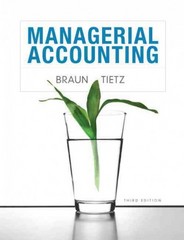Question
1 Assume Farm Grow Chicken classifies all five products as joint products. What are the ending inventory values of each product on July 31, 2017?
1
Assume Farm Grow Chicken classifies all five products as joint products. What are the ending inventory values of each product on July 31, 2017?
2.
Assume Farm Grown Chicken uses the production method of accounting for byproducts. What are the ending inventory values for each joint product on July 31, 2017, assuming breasts and thighs are the joint products and wings, bones, and feathers are byproducts?
3.
Comment on differences in the results in requirements 1 and 2.
Farm Grown Chicken grows and processes chickens. Each chicken is disassembled into five main parts. Farm Grow Chicken is computing the ending inventory values for its July 31, 2017, balance sheet. Ending inventory amounts on July 31 are 23 pounds of breasts, 9 pounds of wings, 8 pounds of thighs, 9 pounds of bones, and 3 pounds of feathers.
FarmGrown Chicken's management wants to use the sales value at spilt off method. However, management wants you to explore the effect on ending inventory values of classifying one or more products as a byproduct rather than a joint product.
Breast Wing Thighs Bones Feathers total
Pounds of Product 125 30 30 60 5 250
Wholesale Price Per Pound $.70 $.25 $.30 $.10 $.05
Sale value splitoff $87.50 $7.50 $9 $6 $.25 $110.25
Weighting Sales value spinoff .794 ..068 .082 .054 .002 1.00
Joint cost allocation Per Pound $39.70 $3.40 $4.10 $2.70 $.10 $50.00
Cost Allocation per pound $.3176 $.1133 $.1367 $..0450 $.0200
Step by Step Solution
There are 3 Steps involved in it
Step: 1

Get Instant Access to Expert-Tailored Solutions
See step-by-step solutions with expert insights and AI powered tools for academic success
Step: 2

Step: 3

Ace Your Homework with AI
Get the answers you need in no time with our AI-driven, step-by-step assistance
Get Started


